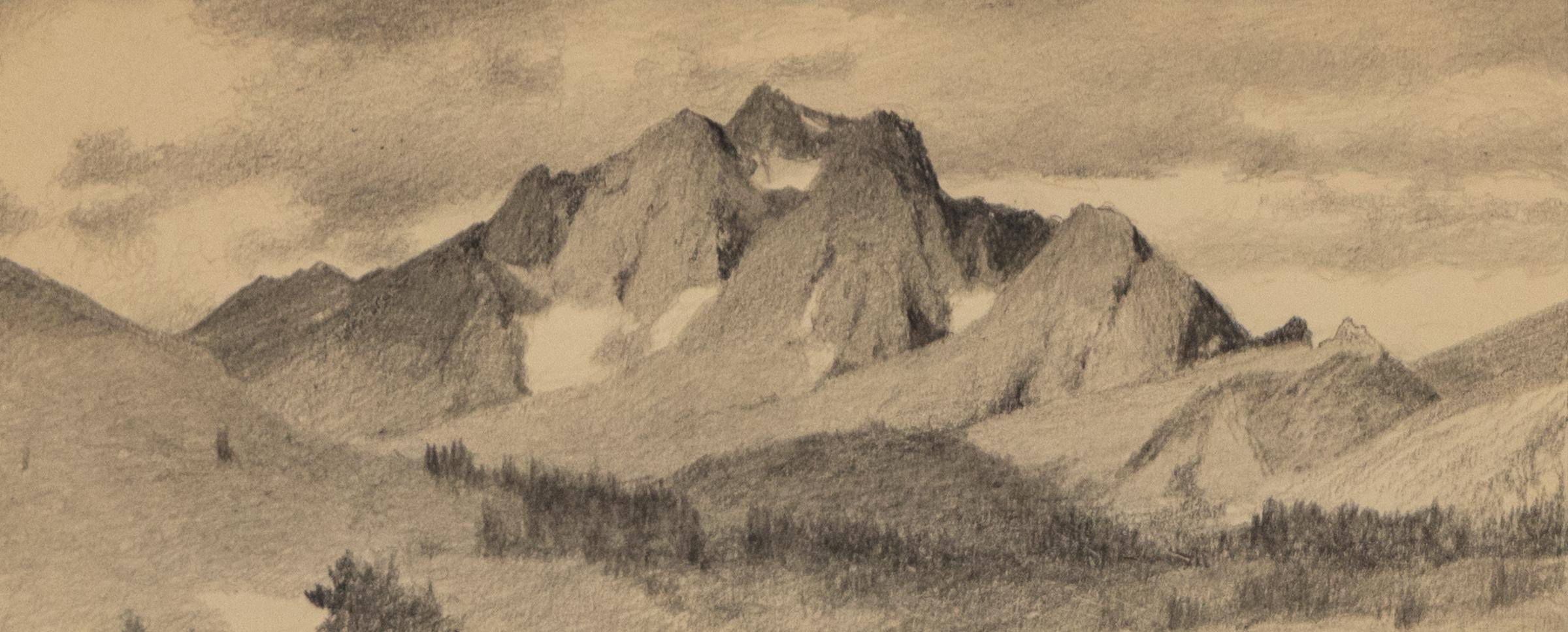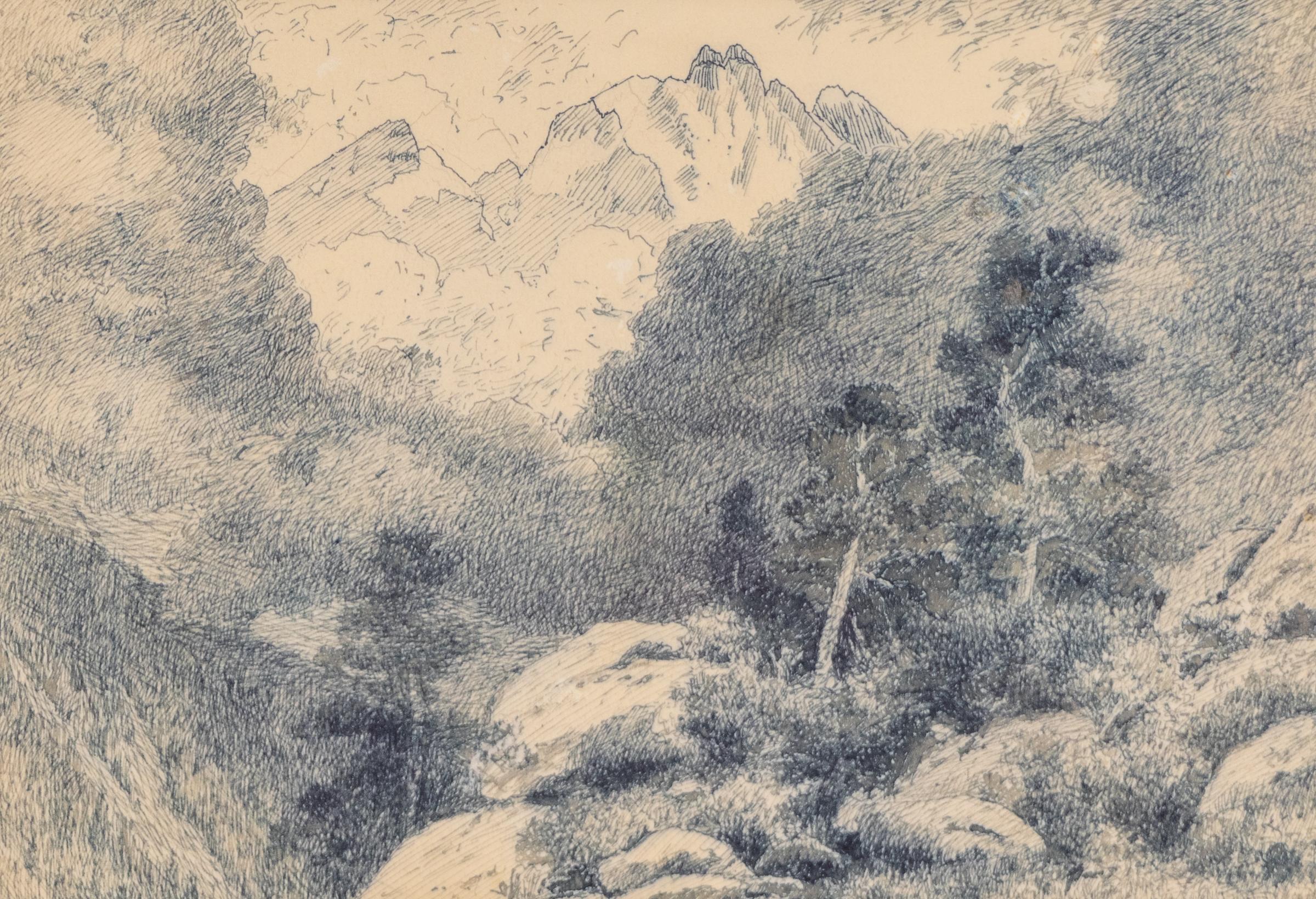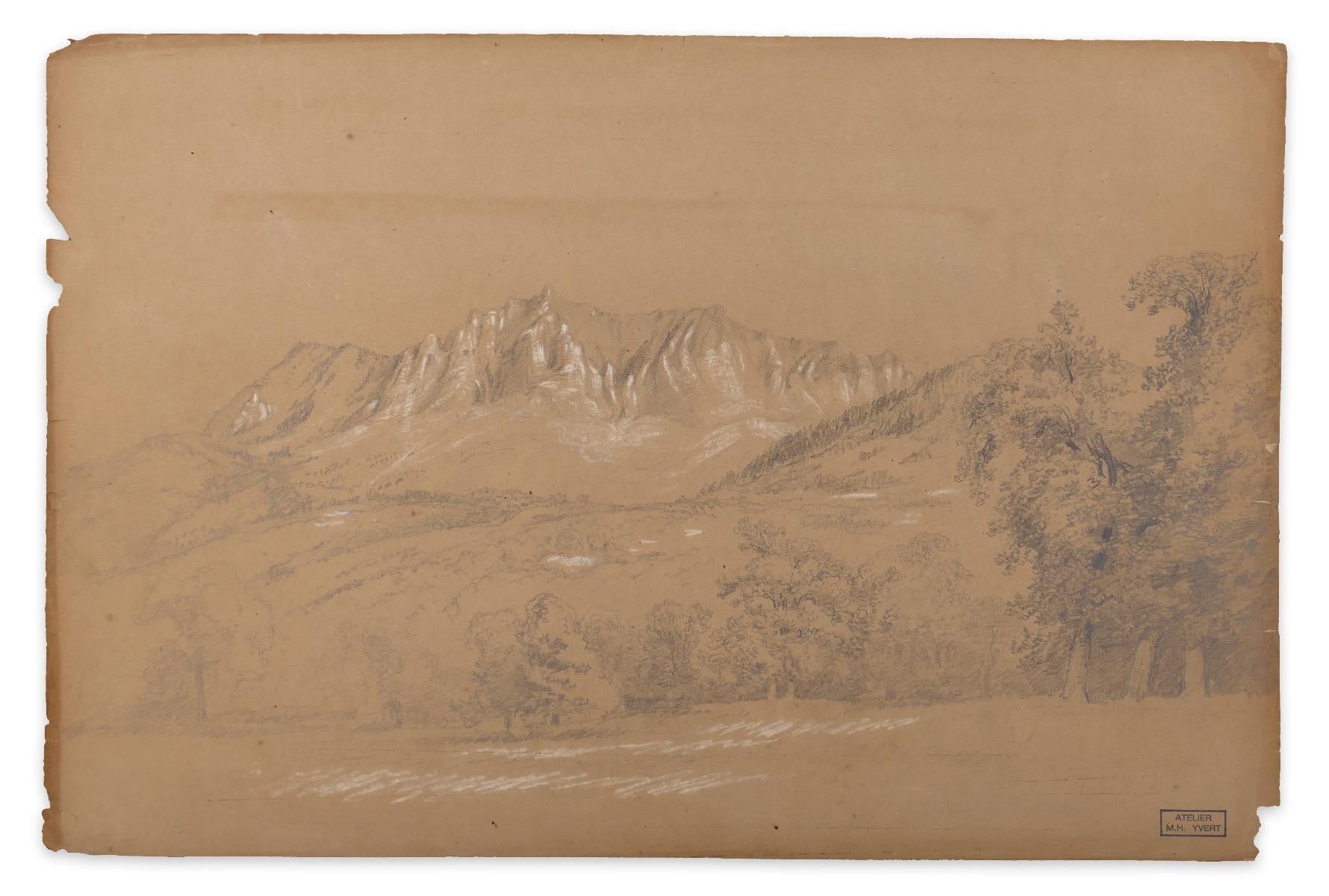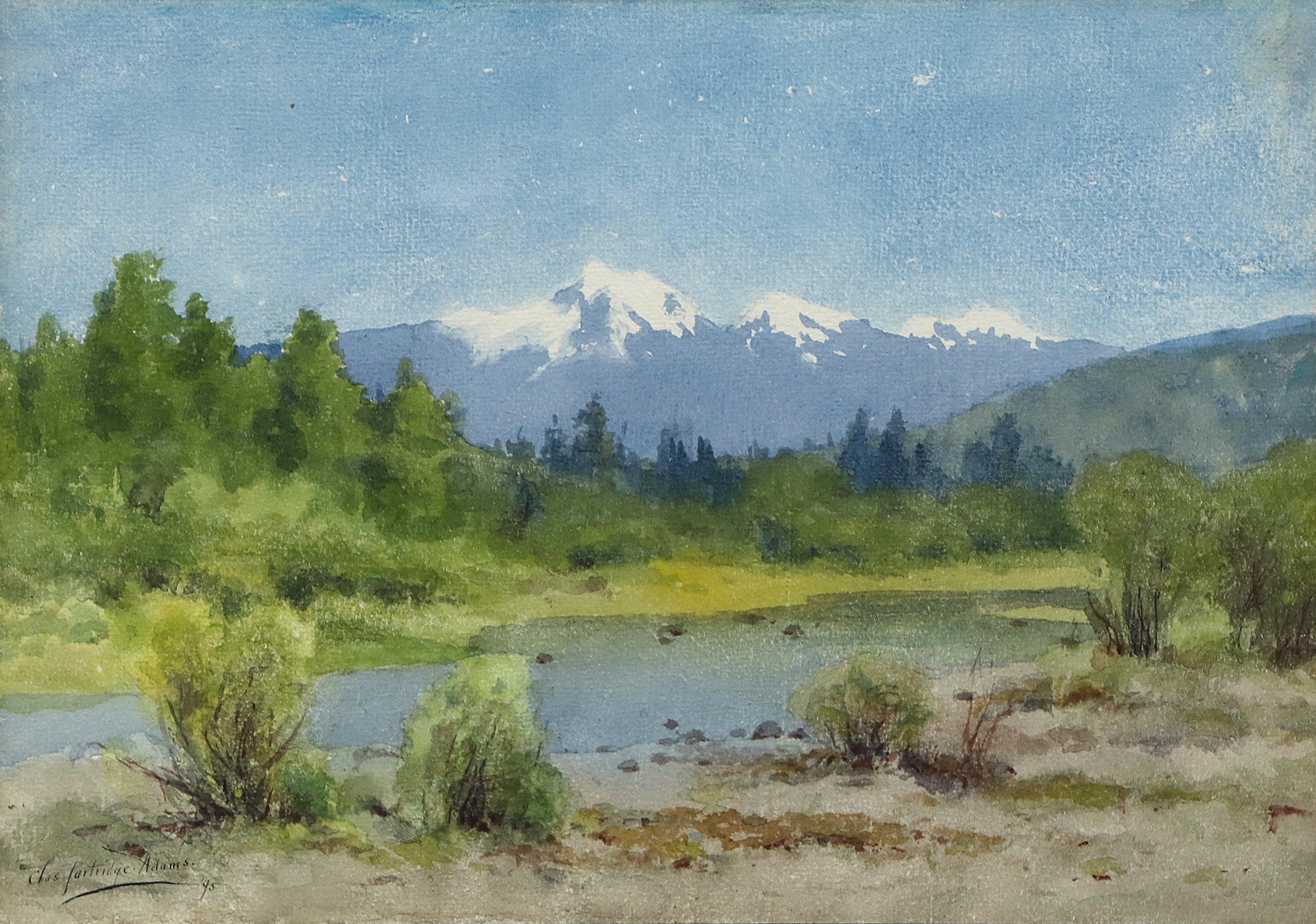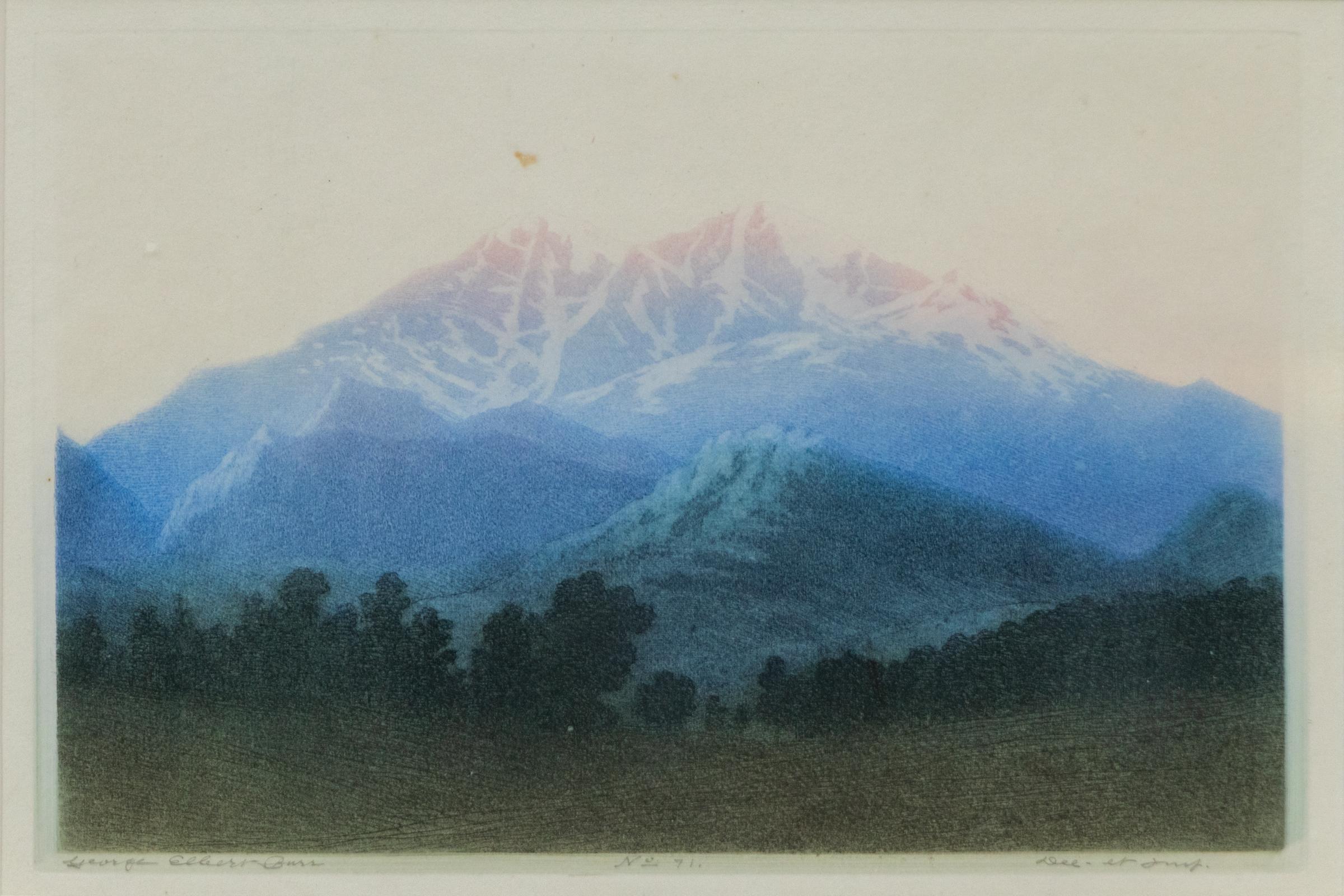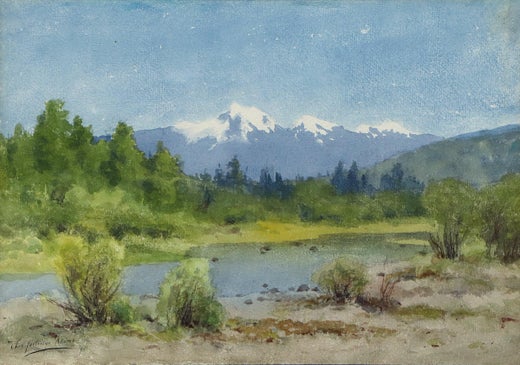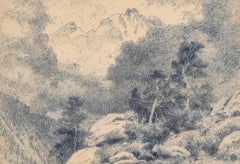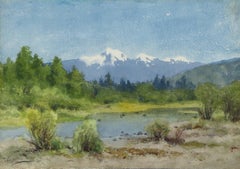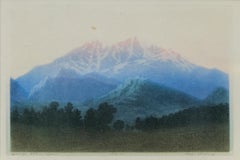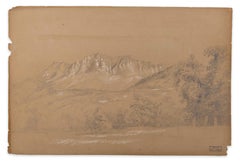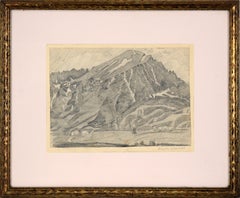Items Similar to Charles Partridge Adams 1910 Graphite Drawing of Twin Sisters Peaks, Colorado
Video Loading
Want more images or videos?
Request additional images or videos from the seller
1 of 10
Charles Partridge AdamsCharles Partridge Adams 1910 Graphite Drawing of Twin Sisters Peaks, Coloradocirac 1910
cirac 1910
$2,250
£1,705.84
€1,970.61
CA$3,185.59
A$3,573.62
CHF 1,847.67
MX$43,099.89
NOK 23,506.23
SEK 22,015.82
DKK 14,707.41
About the Item
This original circa 1910 graphite drawing by Colorado artist Charles Partridge Adams (1858–1942) captures the grandeur of the Rocky Mountains with remarkable detail and sensitivity. The composition features two male figures standing among towering pine trees, with the dramatic Twin Sisters Peaks rising in the background. Located in Rocky Mountain National Park near Estes Park, the scene reflects Adams’s deep connection to the Colorado landscape, which he helped immortalize as one of the region’s most celebrated early painters and draftsmen.
Executed in graphite on paper, the drawing demonstrates Adams’s refined draftsmanship and keen eye for natural forms. This historic work is accompanied by a letter of authenticity and is presented in a custom vintage white-wash wood frame with UV70 protectant glass, ensuring both preservation and elegant display.
Provenance: From the Estate of Charles Partridge Adams, offering collectors a direct link to the artist’s legacy.
A rare and intimate work by a prominent figure in American landscape art, this drawing is a significant piece of early 20th-century Colorado art history.
- Creator:Charles Partridge Adams (1858-1942, American)
- Creation Year:cirac 1910
- Dimensions:Height: 12.25 in (31.12 cm)Width: 152.5 in (387.35 cm)Depth: 1.5 in (3.81 cm)
- Medium:
- Movement & Style:
- Period:
- Framing:Frame IncludedFraming Options Available
- Condition:
- Gallery Location:Denver, CO
- Reference Number:Seller: 257131stDibs: LU27316303952
Charles Partridge Adams
Born in Franklin, Massachusetts, Charles Partridge Adams moved with his mother and two sisters to Denver, Colorado, in 1876 in an effort to cure the two girls who suffered from tuberculosis. In Denver, Adams found work at the Chain and Hardy Bookstore. He received his first, and only, art training from the owner's wife, Helen Chain. Mrs. Chain, a former pupil of George Inness, provided instruction and encouragement to the young artist and introduced him to other artists in the area including Alexander Phimister Proctor. Proctor and Adams developed a friendship and the pair embarked on a three-month camping trip in Egeria Park, Colorado. In addition to exploring, both artists did quite a bit of sketching on the trip. After their return to Denver, Adams and Proctor shared a studio for a short period of time before Proctor moved to New York. Adams remained in Denver and after a short stint as an art teacher he studied wood engraving with Major J.M. Bagley. He quickly abandoned the engraving for health reasons and began working in crayon. His business card read "Landscapes and Crayon Portraits" though he much preferred landscapes. The artist soon made a name for himself in Denver. He established a wealthy clientele that purchased a number of his paintings to decorate their homes and to give as Christmas gifts. In 1890, Adams married Alida Joslin Reynolds and the couple honeymooned in Estes Park, Colorado. That same year, he exhibited for the first time at the National Academy of Design. Three years later, the artist opened his first studio on Larimer Street in Denver. He began working in watercolor and had success in the new medium selling his paintings in stores in Colorado Springs, Pueblo, Kansas City, and Chicago. Also in 1893, Adams became a charter member of the Denver Artists Club. In 1905, the couples dream of living in Estes Park was realized when Adams completed construction on a home and studio there. Adams referred to the studio as "The Sketch Box" and the family spent summers there every year. Though Adams is best known for his Colorado landscapes, he also painted in Yellowstone, the Tetons, the Canadian Rockies, the New Mexican Desert, and California. In 1914, the couple sailed to Europe where they spent five months touring. Three years later, Charles suffered from a near-fatal illness. In 1920, Adams moved to California where he opened a studio first in Pasadena and later in Laguna Beach. He became a member of the Laguna Beach Artists Association and began painting marine subjects. ©David Cook Galleries, LLC
About the Seller
5.0
Gold Seller
Premium sellers maintaining a 4.3+ rating and 24-hour response times
Established in 1979
1stDibs seller since 2013
292 sales on 1stDibs
Typical response time: 8 hours
- ShippingRetrieving quote...Shipping from: Denver, CO
- Return Policy
Authenticity Guarantee
In the unlikely event there’s an issue with an item’s authenticity, contact us within 1 year for a full refund. DetailsMoney-Back Guarantee
If your item is not as described, is damaged in transit, or does not arrive, contact us within 7 days for a full refund. Details24-Hour Cancellation
You have a 24-hour grace period in which to reconsider your purchase, with no questions asked.Vetted Professional Sellers
Our world-class sellers must adhere to strict standards for service and quality, maintaining the integrity of our listings.Price-Match Guarantee
If you find that a seller listed the same item for a lower price elsewhere, we’ll match it.Trusted Global Delivery
Our best-in-class carrier network provides specialized shipping options worldwide, including custom delivery.More From This Seller
View All1910 Colorado Plein Air Landscape Sketch – Mountains, Valley & Field Drawing
By Charles Partridge Adams
Located in Denver, CO
This original circa 1910 graphite landscape drawing is a rare and intimate work by renowned Colorado artist Charles Partridge Adams (1858–1942), celebrated for his mastery of the Ame...
Category
1910s American Impressionist Landscape Drawings and Watercolors
Materials
Graphite
Storm in the Rockies, Colorado Mountain Landscape, Plein Air Ink Field Drawing
By Charles Partridge Adams
Located in Denver, CO
Own a rare, original vintage field study drawing by renowned Colorado artist Charles Partridge Adams. This atmospheric ink-on-paper composition captures the raw beauty of a storm swe...
Category
Early 20th Century American Impressionist Landscape Drawings and Waterco...
Materials
Ink
Colorado Mountain Landscape with River, 1890s Watercolor Painting
By Charles Partridge Adams
Located in Denver, CO
This original late 19th-century watercolor painting beautifully captures a classic Colorado mountain landscape by iconic early 20th century artist, Charles Partridge Adams. The compo...
Category
1980s American Impressionist Landscape Paintings
Materials
Watercolor
Longs Peak, Estes Park, Colorado, No. 2, Original 1920s Aquatint
By George Elbert Burr
Located in Denver, CO
This original vintage color aquatint etching captures the breathtaking beauty of Longs Peak and Mount Meeker, as seen from Rocky Mountain National Park near Estes Park, Colorado. Cre...
Category
1920s American Impressionist Landscape Prints
Materials
Aquatint
Vintage Colorado Mountain Landscape, Original Modernist Graphite Drawing, Framed
By Boardman Robinson
Located in Denver, CO
This original graphite on paper drawing by renowned artist Boardman Robinson (1876-1952) captures the dramatic beauty of a Colorado mountain landscape...
Category
20th Century American Modern Landscape Drawings and Watercolors
Materials
Graphite
19th C. American Impressionist Gouache of Colorado Mountains in Spring
By Charles Partridge Adams
Located in Denver, CO
This original circa 1910s plein air field study by renowned Colorado landscape artist Charles Partridge Adams captures the serene beauty of the Rocky Mountains in a masterful display...
Category
1910s American Impressionist Landscape Paintings
Materials
Gouache
You May Also Like
Alpine Landscape - Original Pencil Drawing by Marie Hector Yvert - 19th Century
By Marie Hector Yvert
Located in Roma, IT
Alpine Landscape is an original artwork realized in the second half of the 19th Century by Marie Hector Yvert.
Original pencil and white chalk on brown paper.
Stamp of Atelier M.H....
Category
Late 20th Century Modern Figurative Drawings and Watercolors
Materials
Pencil, Chalk
Alpine Landscape - White Chalk on Brown Paper by M.H. Yvert - Late 1800
By Marie Hector Yvert
Located in Roma, IT
Alpine Landscape is an original artwork realized in the second half of the XIX century by Marie Hector Yvert.
Original pencil and white chalk on brown pap...
Category
Late 19th Century Modern Landscape Drawings and Watercolors
Materials
Chalk
San Gabriel Mountain Landscape in Black and White - Graphite Pencil on Paper
By Ralph Holmes
Located in Soquel, CA
San Gabriel Mountain Landscape in Black and White - Graphite Pencil on Paper
Detailed mountain landscape by Ralph Holmes (American, 1876-1963).
Signed lower right corner "Ralph Hol...
Category
1940s American Impressionist Landscape Drawings and Watercolors
Materials
Paper, Pencil
$1,320 Sale Price
20% Off
Antique Impressionist Painting "Spanish Peaks" Colorado Mountain Landscape 1900
By Charles Partridge Adams
Located in Portland, OR
A very attractive American Impressionist watercolor & gouache painting, "The Spanish Peaks" Colorado mountain landscape scene, by Charles Partridge Adams (1858-1942), circa 1900.
Thi...
Category
Early 1900s American Impressionist Landscape Drawings and Watercolors
Materials
Watercolor, Gouache
Early 20th Century Plein Air Study for Homesteader Colorado Mountain Painting
By Frank Tenney Johnson
Located in Soquel, CA
Robert Azensky Fine Art is pleased to offer original 1909 sketch study of oil painting "Homesteader Colorado Mountain" painting by Frank Tenney Johnson.
It's always special to see the evolution of a painting through the plein air sketches ("studies") by the artist prior to its painting. Frank Tenney Johnson traveled throughout the Colorado Rockies sketching and painting western landscapes and native American and cowboy figurative art.
Medium: Charcoal on paper
Signature: Lower left corner
Date: "1909" below signature
Condition: Tonal aging and minor edge wear consistent with age and use. See images.
Presented in black painted wood frame
Mat size: 14"H x 11"W
Paper size: 9"H x 6"W
Image size (visible with mat): 8"H x 5.25"W
Frank Tenney Johnson was born in Coucil Bluffs, Iowa, in 1874 not far from the Overland Trail. During his childhood, he saw the steady stream of people heading west in all forms of horse-drawn conveyance. This early exposure to the American West was critical in leading Johnson towards the Western landscape as an inspiration for his work. The resulting body of work is a moody and romantic depiction of a long-gone America, rendered in a style that has become practically a genre all its own.
At the age of ten, Johnson moved from Iowa to Milwaukee, WI. There, he took an apprenticeship with F.W. Heinie, a prominent panoramic painter. After a year with Heinie, Johnson apprenticed for Richard Lorenz, a painter and former Texas Ranger who specialized in depictions of horses and western scenes. It was probably during his time with Lorenz that Johnson decided to focus on western subjects himself. He also started illustrating for regional papers and publications, in order to save money for further training.
Further training, as with many of the artists who populated New Mexico in the early twentieth century, took place at the Art Students League in New York, where Robert Henri, William Merritt Chase, John Twachtman, Kenneth Hayes Miller and F. Louis Mora were in the process of teaching perhaps the last great batch of pre-modernists. Though highly stimulated by the training, Johnson was only able to stay for five months, after which he returned to Milwaukee to work and save money in an effort to return to New York. He was able to do so after a time and, upon returning, established an important professional relationship with Emerson Hough, the editor of "Field & Stream" magazine.
At Hough's urging (and on Hough's dime), Johnson traveled to Hayden, Colorado, where he tagged along with a group of cowpunchers in order to sketch their way of life. Though primarily an artist, Johnson also wrote accounts of his time in Colorado for "Field & Stream." After Colorado came Cheyenne, Wyoming, where Johnson attended a "Frontier Days" celebration; after Wyoming, Johnson traveled to New Mexico, where he observed the Navajos and their threatened way of life. This trip changed Johnson from an academic artist with an appreciation for the west to a truly western artist.
Of particular interest to him, in stark contrast to other western artists of the time like Frederic Remington and C.M. Russell, were the more quotidian scenes of the West. Specifically, Johnson focused upon scenes featuring horses, especially at night. Johnson painted a great number of pieces that featured horses tied up outside of saloons, inns or trading posts for the night, the moonlit night punctuated by the warm glow from the lamps inside. In this, he can be considered a pioneer, as his night pieces still serve as the archetype for such work in western art.
Johnson became quite successful through his work for "Field & Stream." He was chosen to illustrate books by the prominent writer Zane Grey, and his gallery shows sold briskly. In fact, one particular show, at the Grand Central Art Galleries at the Biltmore Hotel in New York, sold out opening night. In fact, one man had bought out the entire show: Amon Carter. Having achieved financial security and comfort, Johnson followed his good friend Clyde Forsythe to Alhambra, CA, where the two established residency and shared a studio.
California treated Johnson well. He and Forsythe founded the gallery at the Los Angeles Biltmore...
Category
Early 1900s Hudson River School Landscape Paintings
Materials
Oil Crayon, Laid Paper
c. 1900 German Watercolor of a Mountainside Trail
Located in New York, NY
Untitled (Mountainside Trail), c. 1900
Watercolor on paper
6 1/8 x 7 3/4 in.
Mat: 8 x 10 in.
Category
Early 1900s Impressionist Landscape Drawings and Watercolors
Materials
Paper, Watercolor
